NCC 2022 Volume One - Building Code of Australia Class 2 to 9 buildings
Search the National Construction Code editions
C2
Part C2 Fire resistance and stabilityThis Part contains Deemed-to-Satisfy Provisions for Part C1. Its sets out Types of fire-resisting construction based on building height, size, use and other relevant factors, FRLs and fire hazard properties, which describe how certain materials react to fire. It also contains construction requirements to facilitate fire brigade intervention.
To clarify that the requirements of C1P1 to C1P9 will be satisfied if a building complies with Parts C2, C3 and C4, and Parts G3 and G6, I1 and I3, if applicable.
Where a solution is proposed to comply with the Deemed-to-Satisfy Provisions, C2D1 clarifies that for most buildings compliance with Parts C2, C3 and C4 will achievecompliance with C1P1 to C1P9. The exceptions to this general rule are as follows
Where a Performance Solution is proposed, the relevant Performance Requirements must be determined in accordance with A2G2(3) and A2G4(3) as applicable (See commentary on Part A2).
| Rise in storeys | Class of building 2, 3, 9 | Class of building 5, 6, 7, 8 |
|---|---|---|
| 4 or more | A | A |
| 3 | A | B |
| 2 | B | C |
| 1 | C | C |
To establish the minimum fire-resisting construction required for Class 2–9 buildings.
Minimum type of construction required
C2D2(1) sets out the minimum type of fire-resisting construction required by the Deemed-to-Satisfy Provisions for all Class 2–9 buildings.
Type A construction is the most fire-resistant type of construction, Type C construction is the least fire-resistant and Type B construction falls between these two.
C2D2(2) requires building elements to comply with Specification 5 for the appropriate type of construction.
Class and height(rise in storeys)
Table C2D2 explains that the required type of construction of a building depends on risk levels as indicated by the Class of building and the building’s height as indicated by the rise in storeys. Note that there could be other factors that need to be considered. For example, C3D3 and Table C3D3 examine the maximum permissible size of fire compartments or atriums in buildings for specific types of construction.
Class of building
The Class of building is a measureof the building’s likely:
Examples
Research indicates that if a fire occurs while a person is asleep, the smell of the smoke will not wake them. Response times in residential buildings are longer than in other types of buildings. The BCA thus requires a higher type of construction in residential buildings. See Table C2D2.
Height of buildings (rise in storeys)
The height (rise in storeys) of the building is relevant as a measure of likely evacuation times and evacuation difficulty.
When using a Performance Solution, Part C2 does not apply and there is no need to refer to the types of construction. Nonetheless, if building proponents using Performance Solutions wish to use Part C2 as part of the solution, they can.
To establish a method for the calculation of the rise in storeys of a building, as a means of helping determine a building’s required type of construction.
What is the rise in storeys—C2D3(1)
Under C2D3(1), the rise in storeys is the sum of the greatest number of storeys at any part of the external walls of a building above ground level and any storeys within the roof space. The reason for the inclusion of any storey within the roof space is that the storey may not have any external walls such as occur with a hip roof.
C2D3(1)(a) and (b) distinguish between the situation where the part of the external walls is within the allotment (in which case it is calculated above finished ground level—C2D3(1)(a)), or on the allotment boundary (in which case it is calculated above natural ground level at that point—C2D3(1)(b)).
The rise in storeys is the criteria used to determine the type of construction. This is because the rise in storeys has an impact on:
Definition of storey
“Storey” is defined in Schedule 1. It is advisable to refer to this definition before calculating the rise in storeys of a building.
Calculation of rise on storeys
The calculation of the rise in storeys includes larger mezzanines (see C2D3(4)(a)) and situations where two or more mezzanines can create a similar impact to larger mezzanines (see C2D3(4)(b)) because of their potential fire load.
The calculation excludes machinery or similar plantrooms at the top of the building because they do not add significantly to the building’s fire load (see C2D3(2)(a)) and storeys below ground level in particular circumstances outlined in Figure C2D3a. This is because basements are not exposed to radiant heat from a fire in another building, nor do they emit any significant heat horizontally.
C2D3(2)(b) describes when storeys partly below ground level are not included in the calculation of the rise in storeys, i.e. when they are treated as basement storeys as described above. Whether a storey is to be excluded from the calculation of the rise in storeys is determined by measuring the extent of the storey above the average ground level at the external wall. If the wall is more than 12 m long, consider only the 12 m length of the wall where the average ground level is lowest. If any wall of a storey is more than 1 m above the average ground level, the storey is included in the calculation of the rise in storeys.
The height of a ceiling in a storey above the average ground level adjacent to the external wall can be determined by calculating the area between the ground level and the ceiling for the length of the wall under consideration (the actual length of the wall or 12 metres, whichever is the lesser) and dividing the area obtained by that length (see Figure C2D3c).
Class 7 or 8 with internal storeyheight over 6 metres—C2D3(3)
Under C2D3(3), a Class 7 or Class 8 building with more than one storey above ground level (see C2D3(3)(a)) and which has an internal storey height of 6 metres or more is, from the point of view of potential fire load, considered to be the equivalent to 2 storeys (see C2D3(3)(b)).
Figure C2D3b illustrates some examples of calculating the rise in storeys of a building.
Figure C2D3a: Section showing storey below ground level included in rise in storeys
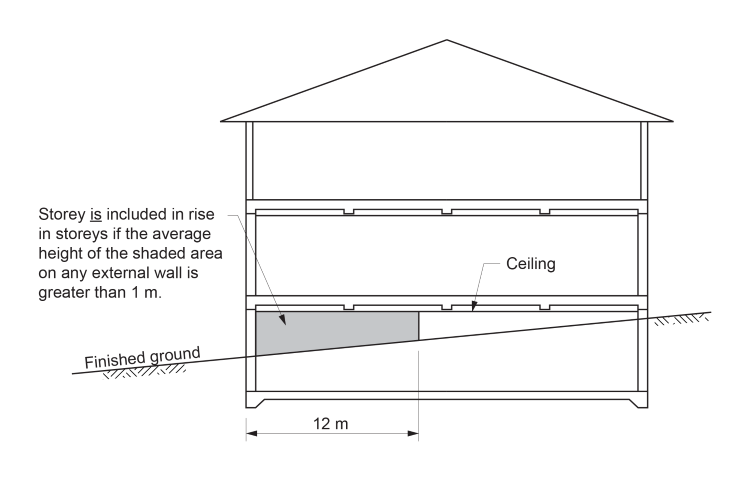
Figure C2D3b: Examples of calculating the rise in storeys of a building
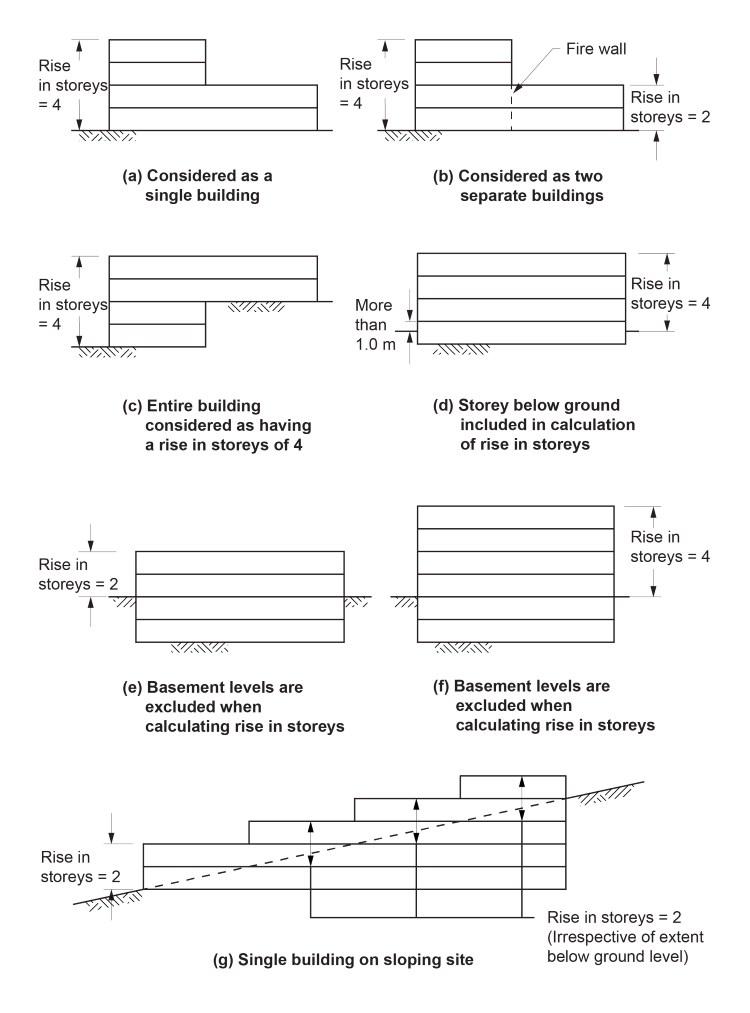
Figure C2D3c: Determining the height above average level of the ground
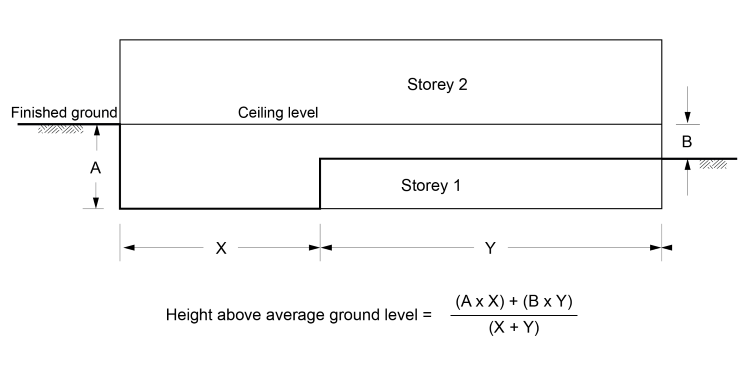
Note: if the wall is more than 12 m long, consider only the 12 m length of the wall where the average finished ground level is lowest (see Figure C2D3a).
To establish the type of construction required for a building that contains more than one Class.
Procedure for determining type of construction
In a building comprising multiple classifications, the type of construction applicable to the classification of the top storey applies to all the storeys below it. Figure C2D4a illustrates this. This method is used to determine the type of construction only, and not the FRLs required for the different classifications.
Figure C2D4a: Method of determining the type of construction required for multi-classified buildings
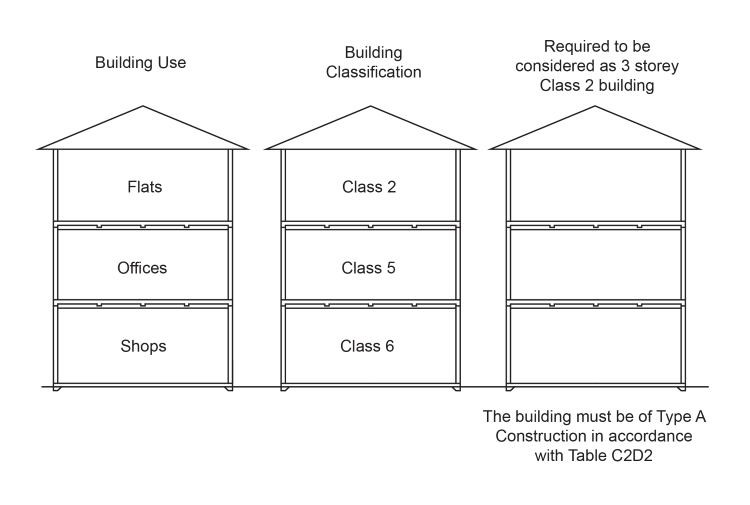
Where a Class 4 part comprises the top storey
To determine the type of construction required when a Class 4 part of a building occupies the whole of the top storey, the class of the next highest storey must be applied to the top storey (see C2D4(2)(a)). When a Class 4 part of a building occupies only part of the top storey, the required type of construction is determined by the class of the other part of the top storey (see C2D4(2)(b)).
C2D7 must be used to determine the appropriate FRLs for the building elementsin the Class 4 part of the building.
Examples
In a 3 storey buildingwith the lower2 storeys of Class 5 and the top storeyentirely of Class 4 the Class 5 classification would be applied to the top storey as shown in Figure C2D4(2). Thus the required type of construction by the use of Table C2D2 would be at least Type B construction.
Figure C2D4b: Multi-classified building for above example
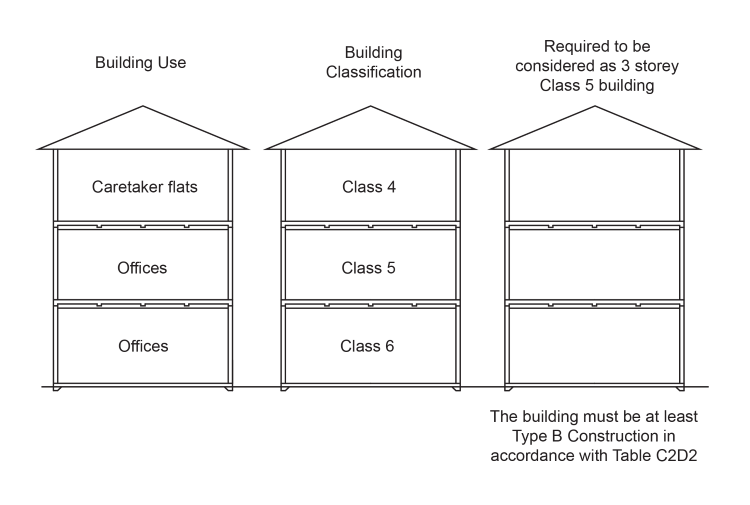
To specify the circumstances in which a building may be of more than one type of construction.
Separation by a fire wall
The only circumstance in which the Deemed-to-Satisfy Provisions allow a building to be of different typesof construction is when the types are separated from one another by a fire wall as described in C3D8(2).
Different types must not be above one another
In no case do the Deemed-to-Satisfy Provisions allow different types of construction to be above one another.
A building having a rise in storeys of 2 may be of Type C construction if—
To grant concessions for:
• low-rise Class 2 and Class 3 buildings provided with a good means of egress; and
• sprinkler protected Class 9c buildings.
Low-rise Class 2 and Class 3 buildings
The concession for Class 2 and Class3 buildings is made on the basis that the level of risk to occupants does not warrant the full application of the type of construction requirements.
The circumstances outlined in C2D6(a) and (b) are alternative options.They do not have to both exist to bring the C2D6 concession into operation.
The concession also applies to a building containing a mixture of Class 2 and Class3. Figure C2D6 illustrates an example of the use of the concession allowed by C2D6.
Figure C2D6: Example of the concession allowed by C2D6
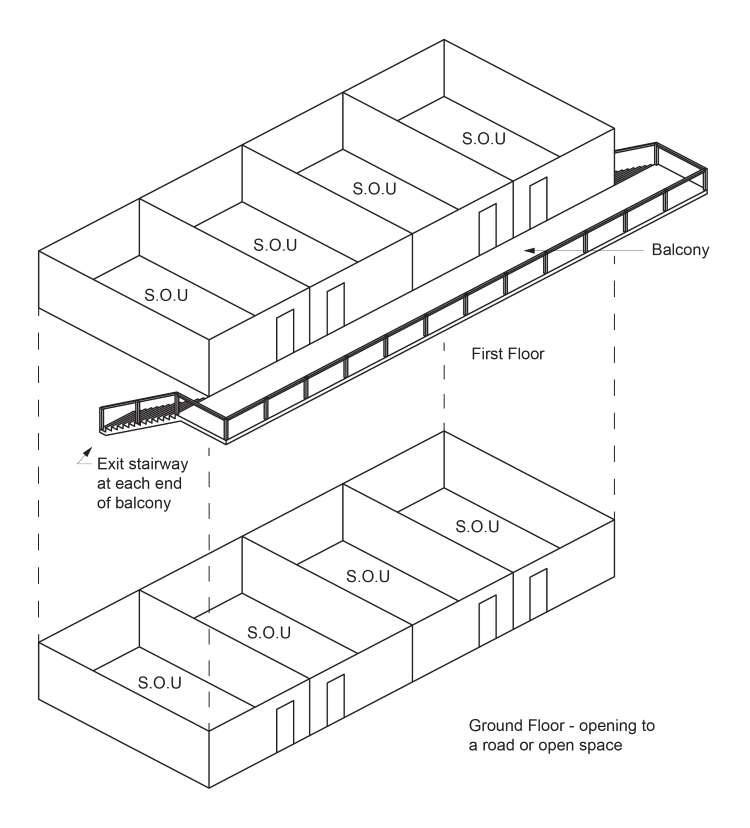
Low-rise Class 9c buildings
The concession for Class 9c buildings recognises the benefits of sprinkler systems and differences between Types A, B and C construction. It must be remembered that the Class 9c building must comply with all the other BCA provisions, including the floor area limitations contained in Table C3D3.
To specify that Class 4 parts of buildings are subject to the same requirements for fire-resistance levels (FRLs) and separation as would apply to Class 2 parts in similar circumstances.
The reason for requiring the same FRL for a Class 4 as a Class 2 building is because the two different classifications have similar fire loads. It should be noted that the Type of construction required for a Class 4 part is determined in accordance with C2D4.
In a building fire, the people most at risk include those who are sleeping. It is therefore important that the residential part ofthe building be fire separated from the other parts. The fire-resistance levels (FRLs) requiredfor structural elements in a Class 4 part of a building are identified in Specification 5.
To grant a concession for open spectator stands and indoor sports stadiums.
Indoor sports stadiums
Under specified circumstances (see C2D8(1)), an indoor sports stadium may be of Type C construction.
The reason for this concession is that although an indoor sports stadium may have a high population, particularly during an event, it generally has a lower fire load than other Class 9b buildings. For example, in most stadiums:
Open spectator stand
Under specified circumstances (see C2D8(1)), an open spectator stand may be of Type C construction. The reason for this concession is that an open spectator stand generally has a low fire load, even thoughit may have a high population, particularly during an event; and is open at the front thereby not allowing the build up of smoke and heat.
Tier of seating—C2D8(2) and Figure C2D8.
C2D8(2) refers to a “tier of seating”. This describes the levels of seating in an open spectator stand. Figure C2D8 illustrates a single tiered open spectator stand, and a two tiered open spectator stand.
Figure C2D8: Single tiered and two tiered seating in an open spectator stand
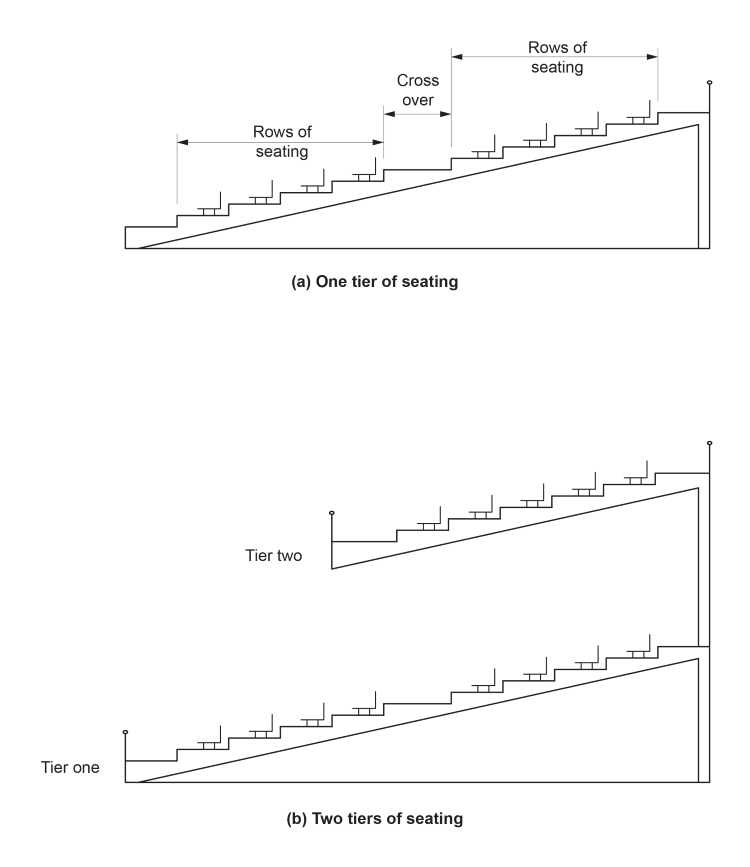
To specify the requirements for the use of lightweight construction in:
• circumstances which require walls with a fire-resistance level (FRL);
• certain high use buildings; and
• fire-resisting covering of steel columns or the like.
Definition of “lightweight construction”
Refer to Schedule 1 for the definition of “lightweight construction”.
Lightweight construction needs protection
Lightweight construction needs protection to preserve its integrity from mechanical damage in a fire or other situation where it may be particularly subject to risk of damage. This is because it is generally more susceptible to damage than other forms of wall construction, such as concrete (which does not contain soft materials) and masonry thicker than 70 mm.
Specification 6
To make sure lightweight construction performs correctly, C2D9 states that it must comply with Specification 6. This Specification sets down tests which such construction must satisfy.
Walls required to have an FRL—C2D9(1)(a)
To make sure lightweight construction performs correctly, C2D9 states that it must comply with Specification 6. This Specification sets down tests which such construction must satisfy.
Walls not required to have an FRL—C2D9(1)(b)
Lightweight construction must also comply with Specification 6 if it is used in a wall system which is not required to have a FRL, but is specifically listed in C2D9(1)(b) or in a building specifically listed in C2D9(1)(b).
There is no requirement to comply with Specification 6 where lightweight construction is used for walls which:
Fire-resisting covering of steelcolumns—C2D9(2)
C2D9(2) sets out the circumstances under which lightweight construction is permitted to be used as a fire-resisting covering for steel columns and the like.
For C2D10(4)(i), isolated refers to localised situations where these elements are used. For example, construction packers and shims used for levelling window frames at fixing points and blocking used to fix a handrail. Blocking an entire wall is not considered to be used in an isolated situation. Isolated fixings and fixing accessories may include, but are not limited to, screws, anchors, wall plugs, nails and washers.
Associated minor elements in C2D10(4)(n) refers to elements such as bar chairs, tie wire and spacers commonly used to support reinforcement in concrete construction.
C2D10(4)(p) applies only to adhesives and tapes associated with stiffeners that may be installed to prevent buckling, bowing or distortion of a cladding material. This provision does not allow for the use of adhesives and tapes as the primary method of support or fixing the cladding material. Refer also to C2D15.
C4D15 is a provision that necessitates the installation of fire-protective materials and components referred to in C2D10(4)(q).
To specify the non-combustibility for building elements and to permit the use of certain materials that are known to provide acceptable levels of fire safety where an element is required to be non-combustible.
The following tables list building elements required to be non-combustible, concrete, or masonry in a building of Type A and Type B construction.
Table C2D10a: Building elements required to be non-combustible, concrete, masonry or fire-protected timber in a building of Type A construction
| Building element | Type A construction |
| External wall | Non-combustible |
| Common wall | Non-combustible |
| Floor and floorframing of liftpit | Non-combustible |
| All loadbearing internal walls (including thoseof shafts) | Concrete, masonry or fire-protected timber |
| Loadbearing fire walls | Concrete, masonry or fire-protected timber |
| Non-loadbearing walls required to be fire-resistant | Non-combustible |
| Non-loadbearing lift, ventilation, pipe, garbage and like shafts which do not discharge hot products of combustion | Non-combustible |
Table C2D10b: Building elements required to be non-combustible, concrete, masonry or fire-protected timber in a building of Type B construction
| Building element | Type B construction |
| External wall | Non-combustible |
| Common wall | Non-combustible |
| Floor and floorframing of liftpit | Non-combustible |
| All loadbearing internal walls (including thoseof shafts) | Concrete, masonry or fire-protected timber |
| Loadbearing fire walls | Concrete, masonry or fire-protected timber |
| Non-loadbearing walls required to be fire-resistant | Non-combustible |
| Non-loadbearing lift, ventilation, pipe, garbage and like shafts which do not discharge hot products of combustion | Non-combustible (subject to conditions outlined in C2D10(2) |
It should be noted that Parts C2, C3 and C4 and the associated Specifications contain some further non-combustibility requirements for certain building elements.
Note also that C2D10 and other Deemed-to-Satisfy Provisions contain a number of concessions from non-combustibility. For example, C2D13 allows fire-protected timber to be used where an element is required to be non-combustible.
C2D10(4) allows a concession from the requirement for non-combustibility for minor ancillary items forming part of an external wall. These minor ancillary items include gaskets,caulking, sealants and damp-proof courses. They may be used wherever a material is required to be non-combustible. In some instances the material may contain combustible components.
C2D10(5) lists materials deemed to be non-combustible and so do not have to be tested to AS/NZS 1530.1. These materials may be used wherever a material is required to be non-combustible. In some instances the material may contain combustible components. The materials listed are not intended to apply to fire place hearths (see G2D3).
To stipulate the minimum fire hazard properties of materials inside a building susceptible to the effects of flame or heat.
Occupants must be able to evacuate
It is important that the spread of fire and the development of smoke be limited during a fire until building occupants have had time to evacuate. See C1P4.
C2D11(1) lists the internal linings, materials and assemblies that must comply with Specification 7.
Materials deemed to comply
C2D11(3) lists materials and assemblies that are not required to comply with C2D11(1). These are deemed to comply and accordingly no tests are required to prove that these materials meet the requirements of C2D11(1).
Fire retardant coatings not acceptable
Some paints have been designed to reduce flame spread on combustible materials. These paints, usually referred to as “fire retardant paint”, cannot be used to achieve any of the required fire hazard properties.
This material is unable to be used because of its susceptibility to damage.
C2D11(2) does not prohibit the use of suitable impregnated materials that achieve the relevant fire hazard properties.
Exempted building parts and materials
C2D11(3) (c) to (n) is a practical recognition that a number of building components and materials are unlikely to significantly contribute to the spread of fire and smoke, because of their size, construction, location and so on. The listed components and materials need not comply with C2D11(1).
C2D11(3)(i) grants an exemption to permit the use of glass reinforced polyester (GRP) in single storey buildings required to be of Type C construction.
The material is limited to GRP because it does not droop or drip when alight. Furthermore, C2D11(3)(i) limits the disposition and quantity of the GRP for use in the roof. This restriction is to reduce the likelihood of the rapid horizontal spread of fire over large sections of roofing.
Accordingly, for the exemption to be used there must be:
GRP does not have the Spread-of-Flame Index and Smoke-Developed Index required by the Specification. However, the C2D11(3)(i) concession is provided because if GRP is installed in the prescribed manner, its use in single storey buildings of Type C construction will not materially increase the risk of spread of fire and smoke.
C2D11(3)(l) refers to elements within buildings such as joinery units, cupboards, shelving and the like which are typically attached to the building structure, however do not form part of the building structure. These elements are exempt as they do not form part of the structure and typically are not included within building works approval. Not withstanding that these elements are often fixed to the building structure for stability, they are generally of low hazard and may be likened to any building furniture which is not subject to the fire hazard properties provisions.
Likewise, C2D11(3)(m) exempts certain types of non-building fixtures such as whiteboards, curtains and blinds, etc. Again, these elements are exempt as they do not form part of the structure and typically are not included within building works approval. It should be noted that not all such fixtures are exempt and reference needs to be made to C2D11(1) to determine which elements must comply.
Concrete external walls that could collapse as complete panels (e.g. tilt-up and pre-cast concrete), in a building having a rise in storeys of not more than 2, must comply with Specification 8.
To minimise the risk of any concrete external wall collapsing outwards as a complete panel during a fire.
See the comments on C1P5 for the reasons for C2D12; and why C2D12 only applies to a building having a rise in storeys of 1 or 2.
Specification 8 contains:
Fire-protected timber may be used wherever an element is required to be non-combustible, provided—
To permit fire-protected timber to be used where an element is required to be non-combustible.
C2D13 provides requirements for when fire-protected timber can be used where an element is required to be non- combustible.
Limitations of the building
C2D13(a) to (c) has specific limitations for a building to use the concession for fire-protected timber.
C2D13(a) requires a building to be a separate building, or a part of building to be separated from the remainder of the building. This includes separation via a fire wall where the part of the building only occupies part of a storey. Where the part of the building is below or above another classification, floor separation must be provided. A fire wall or floor required to have an FRL under C2D13(a)(ii) cannot consist of fire-protected timber.
To use the concession, a height limitation in C2D13(b) requires the building to have an effective height of not more than 25 m. C2D13(c) also requires the building to be sprinkler protected in compliance with Specification 17 (other than by a FPAA 101D or FPAA101H system). This is for the purpose of the C2D13 concession and is in addition to the sprinkler requirements of E1D4.
Construction requirements
C2D13(d) and (e) have specific construction requirements as part of the concession. Under (d), where insulation is installed in a fire-protected timber system, the insulation must be non-combustible.
C2D13(e) requires cavity barriers for fire-protected timber to be provided in accordance with Specification 9. A cavity barrier referred to in C2D13(e) is a barrier/enclosure within, around or adjacent to the fire-protected timber to limit the spread of fire, smoke and hot gases in the event of a fire.
An ancillary element must not be fixed, installed, attached to or supported by the concealed internal parts or external face of an external wall that is required to be non-combustible unless it is one of the following:
C2D14 does not apply to ancillary elements fixed, installed or attached to the internal face or lining of an external wall.
C2D14 does not prevent the mounting of domestic air-conditioning condenser units on external walls.
Ancillary elements fixed, installed or attached to the internal face or lining of an external wall may be subject to other provisions such as C2D11.
To permit certain building components that may contain a limited amount of combustible material to be attached to an external wall required to be non-combustible.
C2D14 prescribes certain allowable ancillary elements that may form part of or be attached to an external wall required to be non-combustible, subject to certain limitations or conditions. These conditions include the ancillary element being constructed of materials meeting certain fire properties, and limitations on its potential extent of coverage of the wall.
For C2D15(1), mechanical support or restraint means fixing that does not solely rely on chemical adhesive and includes concealed fixing systems such as cassette fixing, channel-type fixing and face fixing.
For structural requirements relating to the fixing of cladding, refer to Section B. For most cladding systems, the requirements of Section B will necessitate mechanical fixing of the cladding panel to the supporting frame.
C2D15 stipulates fixing requirements for external bonded laminated cladding panels on buildings that are of Type A or Type B construction. Specifically, all panel layers are to be mechanically restrained.
Adhesives within the bonded laminated cladding panel have the potential to fail during a fire event. In the absence of mechanical fixing, the face of a bonded laminated panel may fall away from a building during a fire. C2D15(1) mitigates against this outcome.
C2D15(2) outlines specific types of bonded laminated cladding panels that are exempted from the mechanical support requirement of clause (1). These include laminated glass systems, layered plasterboard products, perforated gypsum lath with normal paper finish, fibrous-plaster sheet, fibre-reinforced cement sheeting, and components of a garage door.
Often adhesives are used in the process of cladding insulation. For example, double-sided tape may be used to locate a bonded laminated cladding panel on a supporting frame prior to face fixing. The note to C2D15(1) clarifies that this and similar practice is not prevented.
C2D15 ought not be used as evidence that adhesive fixing alone is suitable for bonded laminated cladding panels listed in C2D15(2). Explanatory information to C2D15 indicates that the structural requirements of Section B likely necessitate use of mechanical fixing for most cladding systems.
The external walls of a bulk grain storage facility need not be of fire-resisting construction if—